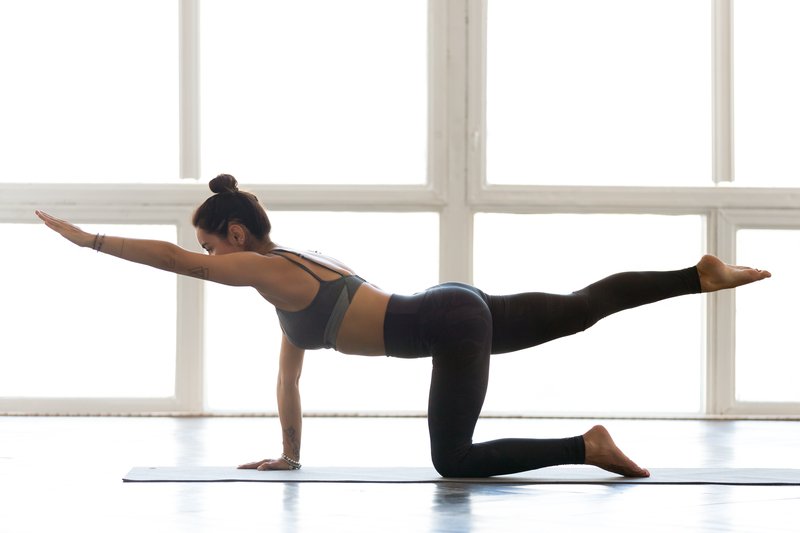Dead Butt Syndrome is Real: See 7 Ways to Reignite Your Glutes

You might feel the urge to chuckle when you hear the phrase “dead butt syndrome,” but would you be shocked to find out that it’s a real thing? It’s true! Dead butt syndrome is prevalent in today’s society due to inactive lifestyles and excessive sitting that most people do. And it’s not going to change unless you take matters into your own hands.
It’s time to get up and get your rear in gear to wake up a dead butt!
What is Dead Butt Syndrome?
With all the sitting we do these days (and we know all too well that’s a bad thing), it’s no wonder there is a “syndrome” caused by the inactivity. What’s the issue that can develop when you spend too much time in a seated position? It’s called “dead butt syndrome,” and yes, there is such a thing.
Yet, even if you don’t spend most of your time sitting, you can develop this condition if you aren’t engaging your glutes regularly and you develop a muscular imbalance. (For example, people who have very strong quads but not hamstrings can develop this condition. Yes, even runners, ballet dancers, and other athletes can develop dead butt syndrome!)
So, what, exactly, happens when you have dead butt syndrome? And why is it something you want to avoid? Well, “dead butt” basically means your gluteal muscles have fallen asleep. This sad state of affairs is called “paresthesia” in the medical world, which sounds like something we all want to circumvent if at all possible.
According to the National Institute of Neurological Disorders, paresthesia is defined as:
“ …a feeling of ‘pins and needles’ (most people have experienced) at some time in their lives when they have sat with legs crossed for too long, or fallen asleep with an arm crooked under their head. It happens when sustained pressure is placed on a nerve. The feeling quickly goes away once the pressure is relieved. Chronic paresthesia is often a symptom of an underlying neurological disease or traumatic nerve damage.”
Because of the muscular imbalance caused by the condition, it can lead to hip and low back pain and even knee and ankle pain along with weak glutes and tight hip flexors.
Why is Dead Butt Syndrome a Dangerous Condition?
Dead butt syndrome (besides the obvious discomfort of a body part falling asleep and then waking up) is no good for a variety of reasons. Not only is blood flow restricted to the body part that falls asleep, but when this happens repeatedly, it can lead to other problems.
What kind of problems? Well, for example, inactive glutes mean that other muscles have to do more work. Your hips, lower back, abs, and even legs will eventually have to help out your glutes on a larger and larger scale as the glute muscles remain unused and become weaker over time.
When other muscles have to put in overtime, it can cause imbalances, tightness, and strain that can be hard to undo unless you get those glutes going again.
Try These 7 Exercises to Wake Up a Dead Butt
There is hope! You don’t have to settle for a dead butt! There are several exercises you can do to wake up those groggy glutes.
1. Glute Bridges—start by lying on the floor on your back with your knees bent and your feet flat on the floor. Place your arms by your sides and bring your heels up toward your butt. Next, lift your hips into the air as far as you can and squeeze. Hold this squeeze for a count of five and then release. Repeat for a total of 15 repetitions.
If you want a bit more of a challenge, you can also lift one leg straight up and do your glute bridge with one leg at a time. Then repeat with the other leg lifted.
2. Glute Bridges with Weight—you can also perform the standard glute bridge with added weight across your hips after you become stronger and get acclimated to the movement. You can use a weighted bar or a light dumbbell to start. Or you can use a looped resistance band around your lower thighs (right above the knees), pushing your knees away from each other as you raise your hips. Perform the same movement as you would without weight or a resistance band.
3. Step-Ups—these exercises may be the king of kings when it comes to waking up those sleepy glutes.
Begin by standing in front of a raised platform, step, or bench. Place your right foot on the platform and use your glutes to propel your body upward until your leg is fully straightened (you’re taking a step up). Bring the back (left) leg up and lightly place it next to your right leg before bending your right knee again to slowly lower yourself back to the ground onto your left foot. Repeat the step-ups five times on the right side and then switch to your left side and repeat the process.
To make the exercise more challenging, you can step up onto a taller platform, or you can hold a dumbbell in each hand.
4. Kneeling Kickbacks—start on the floor on your hands and knees. Keep your head in a neutral forward-facing position. Take your right leg and kick it out behind you and upward. Hold it in the upward position for a count of 5. Release and return your knee to the ground. Repeat on the opposite side. Do ten reps for each leg.
You can kneel on a yoga or gym mat or even on a flat pillow if you find your knees hurt in this position.
Remember to keep breathing throughout the movement!
5. Banded Side Steps—stand and place an exercise band around your ankles. With your hands on your hips and your knees slightly bent, take your right leg and step out to your right side, resisting the urge to let your knees collapse inward (they will want to, and this is where the glute activation comes into play). Bring your left foot in toward your right foot until they are about 12 inches apart. Step out to the side again, this time going to the left and leading with your left foot. Repeat on both sides for a total of ten reps on each side.
If you have access to a gym:
6. Abduction machine—from a seated position with your knees together on the machine, move your legs out to the sides as far as you can. Hold for two seconds at the top of the movement before allowing your legs to slowly come together again. This is one repetition. Do 15 to 20 reps. (You can also do this with a booty band around your knees if you don’t have access to gym equipment).
7. Stepmill Machine—if you don’t have access to hilly terrain or a lot of stairs, you can activate the glutes on a stepmill. These machines resemble an escalator and can be found at numerous fitness facilities. They’re tougher than you think, so start at a relatively low (slow) speed/level and work your way up slowly. Remember to squeeze your glutes as you step up.
In addition to performing these exercises a time or two a week, you can also help wake up your sleepy butt by standing up and taking a break from your chair frequently throughout each day. If you have access, take the stairs when possible. Do some desk stretches and even squeeze your butt muscles, and start to mix up your day a bit by standing as you work, doing some squats or leg lifts as you watch TV, and taking time to move throughout your day and evening.
Dead Butt Syndrome: A Recap
Now that you know why your butt has been feeling “dead” or at least tingly or sore, you can bring it back to life and keep it in good form. However, if the muscle imbalance is significant (or these exercises don’t seem to help), please visit with a physical therapist to help you get to the bottom of the issue.




 7 Signs Your Body is Seriously Low on Collagen (not just wrinkles)
7 Signs Your Body is Seriously Low on Collagen (not just wrinkles) Health Expert: "Turmeric Doesn't Work (unless...)"
Health Expert: "Turmeric Doesn't Work (unless...)" 3 Warning Signs Your Probiotic Supplement is a Total Waste
3 Warning Signs Your Probiotic Supplement is a Total Waste

